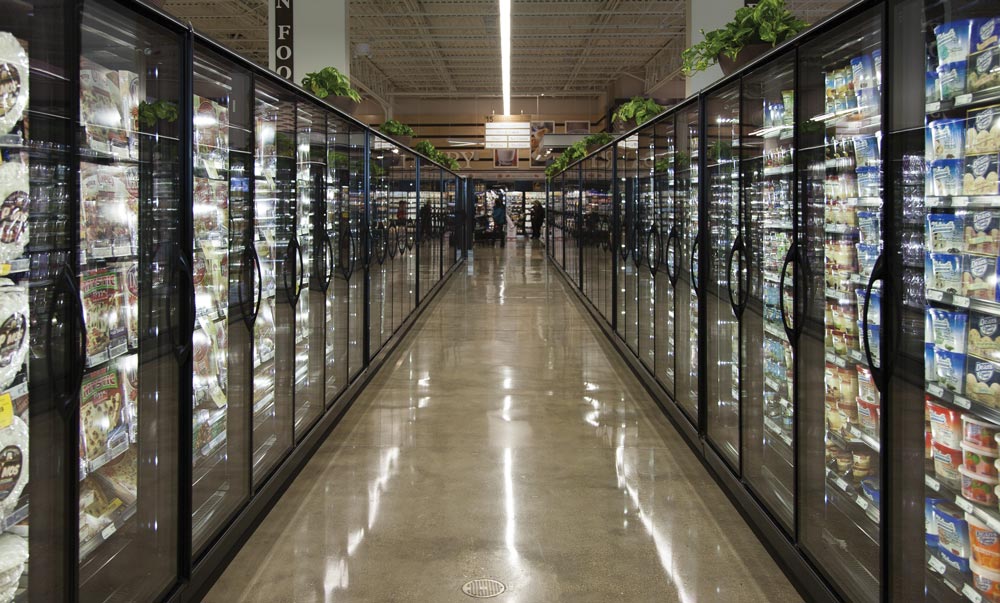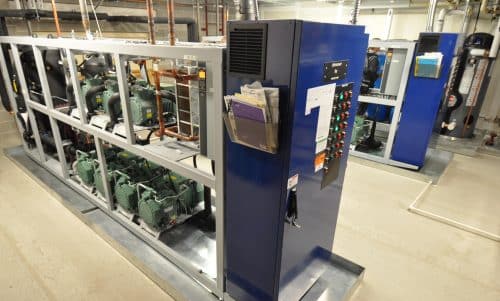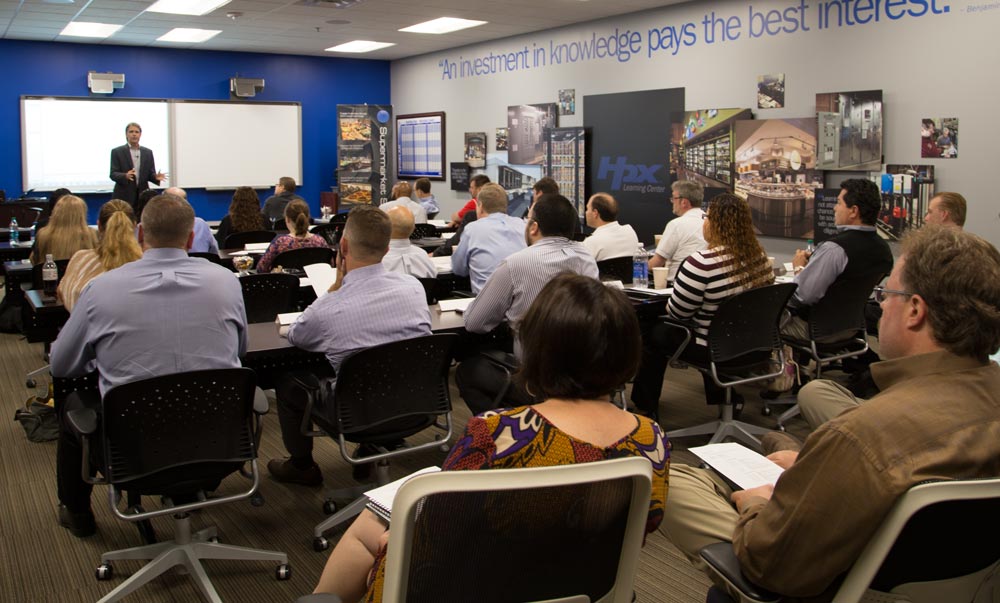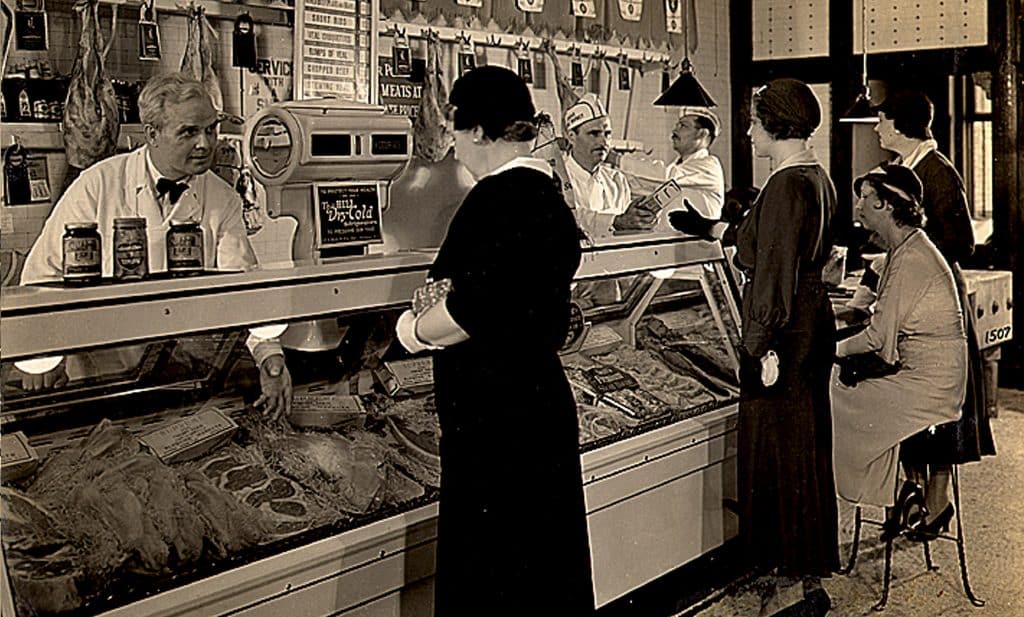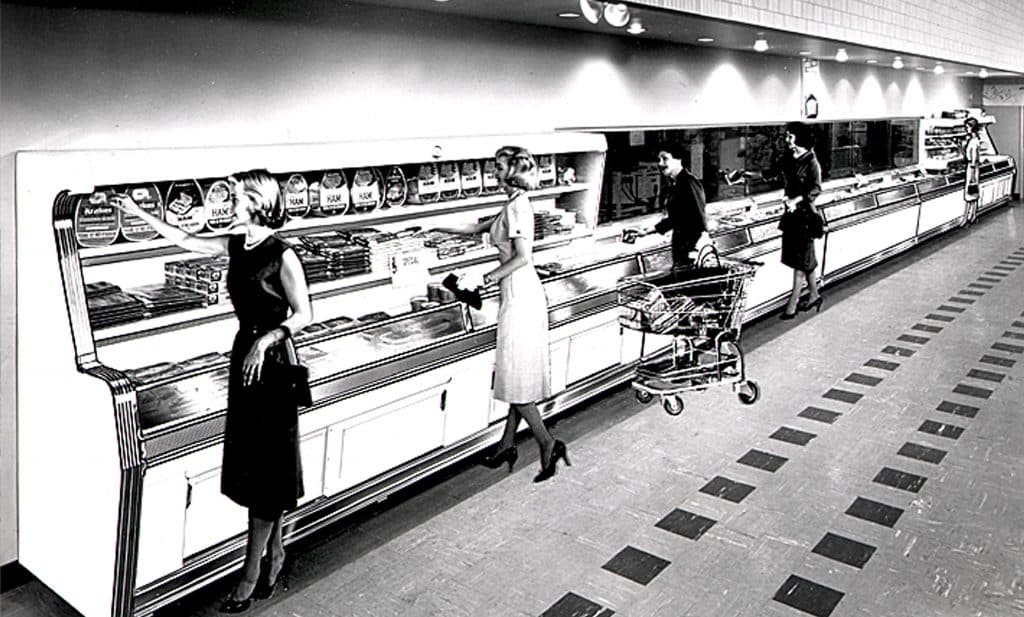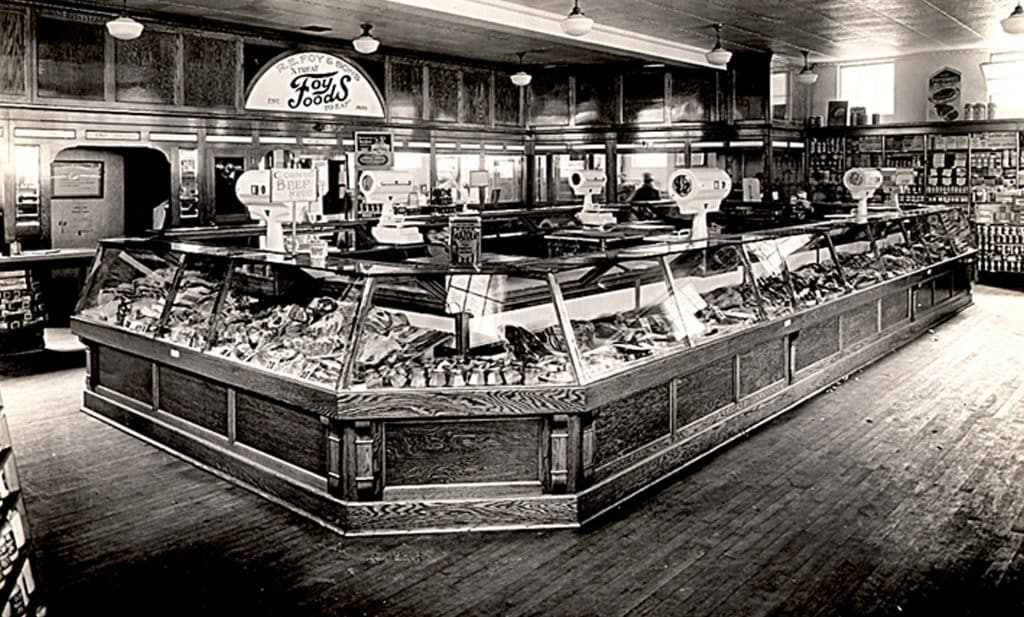More than 130 years of fresh thinking and responsible solutions for retail and industrial refrigeration
Food Retail
From food safety to sustainability to merchandising, Hillphoenix is the leading retail refrigeration company offering complete solutions that deliver a competitive edge. Future-proof your business with our wide selection of commercial refrigeration systems, including our award winning Second Nature® line of sustainable refrigeration systems that run on glycol, CO2 and ammonia. Boost your bottom line with creative store design, lighting, departmental programs, and merchandising display cases that create a dynamic, profitable shopping environment.
Aftermarket Services
The Hillphoenix AMS Group shows customers how to cut operational expenses and boost the bottom line with energy-saving products and services that improve the store environment, optimize performance and increase profitability. From incentives and rebates to recommissioning, the AMS Group helps customers identify opportunities to save energy and improve the retail shopping experience.
Design Services Consulting and Education
The Hillphoenix Design Center is a collaborative workspace and showroom where Hillphoenix design professionals work with food industry retailers and experts from around the world to bring ideas to life. Explore every aspect of food retailing from operations to merchandising to store technologies. Our Design Center experts are eager to share what’s new in store design, lighting, departmental programs, merchandising display design and energy efficiency.
Industrial Refrigeration
The Hillphoenix industrial refrigeration team offers an extensive line of products and services for specialized applications including cold storage, food processing, biopharma and ice rinks. Our dedicated industrial refrigeration team designs, engineers, and manufactures custom systems to meet critical process requirements.
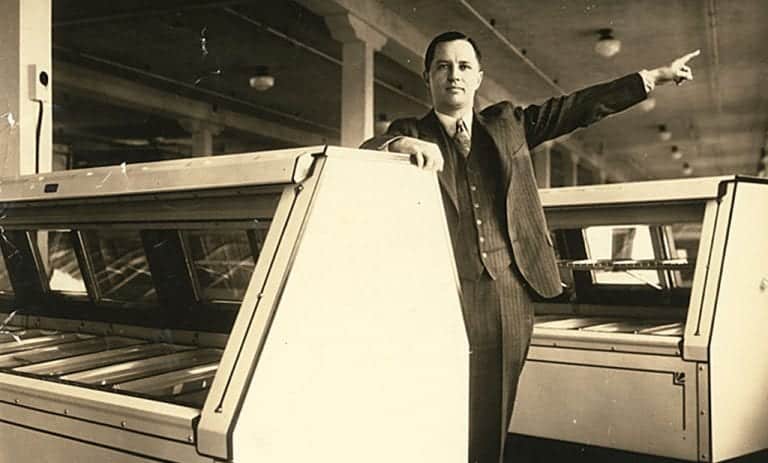
A Legacy of Innovation
1887
The origin of Hillphoenix dates back to 1887, when C.V. Hill, a New Jersey grocer, dissatisfied with the coolers currently available to him both with regard to price and performance, decides to build his own. Because Mr. Hill “dislikes lifting out the heavy butter and lard tubs stored in the coolers”, he invents a butter slide which comes out automatically when the cooler door is opened. This is the first of many patents the company will own as new ideas are initiated over the decades that follow. A neighboring grocer hears of the unit, and when he sees it, buys it on the spot. Mr. Hill sells another cooler and then decides to go into the cooler manufacturing business, as he says, “for a few years,” then return to the grocery store. He starts a new company and names it, C. V. Hill Refrigerator Works. He never returns to the grocery business deciding instead to focus on developing better ways for grocers to display perishable products. Not only is a company born but so is an industry.
1889
Mr. Hill learns about refrigeration and air circulation on the first two coolers he builds, and in 1889, he establishes his first factory. He builds two more refrigerators and shows them at the first Trenton State Fair. Although he enjoys the fair, he does not sell any products. In March of 1890, he sells two refrigerators at $115.00 each. He also invents the first baffle and bunker system for ice-refrigerated coolers. This “puts him on the map in Trenton.”
1896
By 1896, Hill Refrigerator Works moves to a larger facility in Trenton, N.J., and begins to receive orders from the government and steamship operators as well as from grocers. As the turn of the century arrives, Mr. Hill starts developing refrigerated show cases, and in 1905, introduces the first Hill refrigerated show case. As he continues to develop show case concepts, he is particularly focused on developing the first refrigerated display case for fresh meat. Around 1909, utilizing the growing availability of the electric motor and ammonia as the refrigerant, Mr. Hill begins to make a name for himself as grocers up and down the Eastern Seaboard want to buy his meat cases for their stores. Hill Refrigeration Company is born.
1920s
In the early 1920s, the company develops the first top display case which allows customers to view the merchandise inside. Other innovations include the 1927 introduction of the first all-metal case and the 1928 introduction of the first display case capable of maintaining frozen food and ice cream at the right temperatures. When Swift and Company is looking for a case to use for frozen meat, they are surprised to learn that one has already been developed by Hill. Swift uses the Hill case successfully in their laboratory test helping to establish the retail frozen food business in grocery stores. In 1929, Hill installs the first frozen food case in a retail food store, and in 1930, Clarence Birdseye recommends the use of the Hill 2000 model to display the Birdseye “frosted foods” then being introduced in the marketplace.
1932
In 1932, Mr. Hill retires, leaving the company in the very capable hands of his sons, C. V. Hill, Jr. and J. S. Hill. That same year the company creates the first porcelain-clad cases, providing retailers with a more durable case that is easier to clean. In the next few years, the company introduces the first service deli case with mezzanine shelving and storage in the bottom area. As the 1930s introduce larger self-service stores, Hill Refrigeration is ready, once again leading the way with their new “add-a-unit” feature, developed in 1939, which allows cases to be adjoined in a continuous lineup. This feature is perfect for the larger stores that are being built and catches on with grocers all over the country.
1934
At the height of the depression, the company scores another first, only this one is in the area of marketing. Hill Refrigeration publishes a book called “Modern Food Merchandising” in 1934 which enumerates guidelines on successful food marketing. The book is enthusiastically received, and five editions are published. The company also builds its own grocery store, both to test its new equipment and to try out new merchandising ideas. During World War II, Hill manufactures landing craft for the military along with refrigerators for use on Navy vessels. When the war ends, the company is in an excellent position to meet the demands of the food industry for new equipment since it was able to devote significant time in research and development efforts focused on making war-time products better.
1945
Hill Refrigeration announces a major breakthrough in refrigerated display case design — a three-deck open dairy case. This mechanical and merchandising breakthrough maintains temperature on each level while showcasing a greater quantity and variety of product. The new case not only gives grocers an attractive display setting that stimulates impulse sales, it also allows them to show much more quantity and variety in the same floor space. The case breaks new merchandising ground and helps speed the spread of “self-service shopping.” The immediate success of the new Hill dairy case leads to the introduction of the Hill self-service open frozen food cases with the “add-a-unit” feature and automatic defrost.
1950s
During the 1950s, Hill dramatically expands its manufacturing capabilities to meet the requirements of the many new “supermarkets” that are being built for the ex-soldiers and their families who are moving in huge numbers to the suburbs. In 1953, Hill becomes the first manufacturer to offer grocers the option to add color to their display cases. The introduction of “Color Blend” styling leads a design transformation in an industry that previously only offered one color — white.
1964
Up to this point, Hill Refrigeration has been a family-owned operation. In the 1950s, the company is sold, and after a series of owners, Hill becomes a division of Emhart Corp. in 1964.
1967
The “Color Blend” trend that began in 1953 culminates with the 1967 introduction of the Vista line of medium-temperature cases. The Vista line offers a departure from the traditional white boxes by expanding the range of available colors and sporting sleek, streamlined styling.
1970s
With the arrival of the 1970s comes the nation’s first real energy crisis. Hill Refrigeration responds by improving the energy efficiency of its cases and by developing technologies to allow grocers to capitalize on the most efficient refrigeration systems for their specific needs. In 1971, the company introduces a new five-deck frozen food case, the most efficient in the industry, and it immediately becomes the best-selling multi-deck case.
1977
In 1977, Georgia entrepreneur, Grant Brown, recognizes a neglected niche in the market for custom refrigeration systems and starts Engineered Supermarket Products (ESP). Immediately, ESP introduces the first uneven parallel system and begins to establish a leadership position in the refrigeration systems market.
In 1980, ESP is sold and ultimately becomes the company known today as Emerson CPC Controls. That same year Grant Brown forms a new company, names it Engineered Refrigeration Systems (ERS), and continues to expand his presence in the custom refrigeration systems business.
1981
At the FMI 1981 trade show, Hill unveils the first U.S.-manufactured curved glass service deli case. The prototype creates much positive response, and as a result, Hill develops the first complete line of curved glass service cases to meet the varied needs of its customers.
1985
In 1985, Grant Brown sells Engineered Refrigeration Systems to Margaux, Incorporated. In 1988, realizing that the niche is still unfulfilled, Grant re-enters the market, forming a new company which he names Phoenix Refrigeration Systems and completely changes the nature of system design with innovative ideas such as the introduction of the first pre-fabricated mechanical centers and electrical distribution centers. Phoenix Refrigeration Systems quickly becomes a major designer and manufacturer of refrigeration systems in the United States.
1990
In 1990, Hill Refrigeration introduces a new look for Hill cases. The ORIGIN™ line represents a bold departure in case styling, featuring soft, rounded exteriors with a distinctly European flavor. Hill pioneers the use of polymers which permits the creation of curved bumpers and rounded edges while increasing the durability of the cases. No other case on the market looks like this one.
1993
Phoenix Refrigeration Systems is acquired by Dover Corporation in 1993, and in 1994, Phoenix acquires Hill Refrigeration to form Hillphoenix®. The merger of Phoenix Refrigeration Systems with Hill Refrigeration is a natural and the circle is completed one year later when Hillphoenix acquires Margaux Refrigeration, the company that acquired ERS from Brown 10 years earlier.
1995
Display Case Operations relocate to a new 450,000-square-foot factory in Chesterfield County, Va. in 1995. The new facility is outfitted with state-of-the-art equipment and expanded manufacturing processes for producing Hillphoenix cases. The stream of innovative new product lines continues with the 1995 introduction of ORIGIN2® which extends the exterior case makeover of ORIGIN to the interior. The redesign features: curved tanks for improved sanitation; improved coils and fan plenums for increased efficiency, sanitation and ease of maintenance; and upgraded lighting for better product display. The ORIGIN2 line also introduces Radial Airflow®, a patented feature that improves airflow for better case performance, and removable casters to aid in assembly line movement, in shipping, and in the installation of cases in stores. No other case in the industry offers this patented, convenient feature. In 1995, Hillphoenix is the first to introduce secondary coolant refrigeration technology to the supermarket industry both as a “green” environmental initiative and as a system with positive design advantages over conventional direct expansion systems. After seven years’ performance experience for its growing installed base of secondary coolant systems at many of the top U.S. chains, in 2002, the company brands its secondary coolant technology Second Nature®. Hillphoenix Second Nature technology includes secondary coolant system design and installation, low- and medium-temperature merchandisers, walk-ins and prep rooms.
1997
In January of 1997, a team of 40 Hillphoenix associates meets over a long weekend and develops a statement of purpose that defines the Hillphoenix commitment to achieve a leadership position in the industry through the delivery of excellence to customers. This call to action continues to clearly communicate the company’s ideals and goals, providing every Hillphoenix associate with the focus and direction needed to provide answers that help our customers be successful. It is in fact a rededication to the principles that C.V. Hill and Grant Brown were dedicated to when they started the respective businesses that became Hillphoenix.
The Hillphoenix Statement of Purpose
- We will lead the markets we serve with innovative products, solutions and technical advances in a relentless pursuit to exceed customer expectations.
- We will create a culture that promotes teamwork, integrity and respect for our customers, our suppliers and ourselves.
- We are intolerant of mediocrity and dedicated to continuous improvement as a way of life.
- As a result, Hillphoenix will enhance the success of our customers, the return to our shareholders, and the satisfaction of our employees.
Also, in 1997, Electrical Distribution Systems (EDS), a Dover Diversified Company, manufacturer of electrical distribution systems that was originally started by Grant Brown during the Phoenix Refrigeration years, is merged back into Hillphoenix. EDS, located in Covington, Ga., becomes the Power Systems Division of Hillphoenix. Power Systems designs and manufactures pre-assembled, pre-wired electrical distribution products, including PowerCenter®, PowerPlus, Power On, and Power Flow, industrial enclosures and solar equipment.
1999
Hillphoenix re-enters the Walk-In Cooler and Freezer business in 1999, and in 2009, begins a series of major commitments in people, plants and processes, all focused on creating the industry’s leading Walk-In business. Today, the mission of the Hillphoenix Walk-In division is consistent with the same mission Mr. Hill had when he started the Hill Refrigerator Works cooler business in 1889 — to provide the Food Retail industry with high quality products and services that exceed our customers’ expectations. With a renewed focus on providing innovative product designs and customer service, the people who make up Hillphoenix Walk-In look forward to the opportunity to serve our customers’ needs in a more comprehensive manner than they have ever experienced.
2002
As the 21st Century gets under way, Hillphoenix continues its leadership position as an industry innovator with a strategic direction dedicated to developing products focused on making supermarket operators more effective operationally and financially. The May 2002 introduction of the proprietary Coolgenix® display case technology provides retailers with the opportunity to reinvent their service departments. The patented, secondary coolant conduction design enables significant increases in product shelf life and dramatically reduces product shrinkage.
2003
At the 2003 May FMI Show, the introduction of the new ORIGIN2 display case technologies, including the industry’s first six-door reach-in display case and a focus on efficiency in system and display case design and performance, provides customers with answers to energy cost concerns. Hillphoenix introduces “The People Factor Makes the Difference”, a campaign that celebrates the impact that the people and the culture that make up Hillphoenix have in providing daily examples of Hillphoenix’ s century-long commitment to providing specific answers to customer challenges.
2004
In 2004, Hillphoenix introduces the industry’s first true 5-deck rear load fresh meat case, the O5MR, and its companion O5M front-load model. A key feature is a patented articulating shelf design that provides supreme product integrity and striking display opportunities.
2005
In 2005, a team is formed and a charter created that leads to an intense focus on the development of the industry’s most extensive product and process training program. The Hillphoenix Learning Center is launched in June of 2006. President Ray Hoglund says at the time, “Throughout Hillphoenix, we believe we can only provide the individual answers that help improve the profitability of our customers by supporting our sales force and customers with top quality training. I am pleased to announce the opening of The Hillphoenix Learning Center. We have made a very significant investment in the development of distinctive product training programs, increased our training staff and renovated our facilities in order to provide the best possible product training experience using state-of-the-art technology. I invite you to learn about Hillphoenix Answers — people, products and technology working together for a brighter future.”
2006
In 2006, as environmental concerns move to the forefront of the industry’s focus, Hillphoenix Refrigeration Systems Division begins redesign work on the distributed systems offering that was first introduced in 1984. The ParaTemp® and WeatherPac® system designs are updated and the industry’s most complete and efficient indoor distributed system, InviroPac™, is introduced. Also, in 2006, the company’s Refrigeration Systems Division installs the first test stores utilizing CO2 as a secondary fluid at sites in Montpelier, Virginia and Savannah, Georgia.
2007
In 2007, Hillphoenix becomes the first refrigeration equipment manufacturer to join the U.S. EPA’s GreenChill Refrigeration Partnership program. As a charter member, Hillphoenix is instrumental in helping the EPA work together for the first time with supermarket retailers to develop this partnership program designed to advance the deployment of sustainable refrigeration technologies. That same year, Hillphoenix releases its first Sustainability Report, the first from a refrigeration manufacturer. There is no doubt that at this time, Hillphoenix leads the way in the commitment to and development of sustainable technologies for its customers.
Also, in 2007, two distinguishable energy-saving technologies are introduced by Hillphoenix. The company starts extensive field testing of SmartValve®, a patented superheat management system designed to help customers ensure that display case superheat is maintained at a pre-set condition eliminating adjustments that are typically required to maintain optimum efficiency. And Climate Keeper™, a proprietary air distribution system, is introduced during the FMI Energy Conference.
2008
2008 brings the first test site utilizing a new Hillphoenix Second Nature CO2 Cascade system design. Installed at a Price Chopper location in New York, this design provides yet another example of Hillphoenix’ s commitment to work together with its customers to continue moving the technology envelope forward in an effort to help them implement their sustainability plans. Also, in 2008, Hillphoenix works with Food Lion to install the first full store test site utilizing Second Nature glycol medium-temp systems and CO2 secondary coolant low-temp systems. And, in 2009, Hillphoenix receives two awards from the U.S. EPA; an Ozone Layer Protection Award and the 2008-2009 GreenChill Advanced Refrigeration Award.
2009
In 2009, Hillphoenix completes two key acquisitions. In May, the company acquires key assets of Tyler Refrigeration and the opportunity to welcome many key dealers from the Tyler Dealer Network to the Hillphoenix Dealer Group. As a result, the Hillphoenix Dealer Network immediately becomes the largest of any manufacturer, servicing the needs of customers in the U.S. and Canada. And, in November, Hillphoenix acquires Barker Company of Keosauqua, Iowa creating Specialty Products by Hillphoenix. Both acquisitions help deliver strategic initiatives directed at helping food retailers sell more products, more profitably and more responsibly, driving significant growth with existing and new customers.
This year (2009) also sees the introduction of Hillphoenix’ s proprietary Clearvoyant® LED lighting system, designed specifically for use in Hillphoenix display cases. And Hillphoenix becomes the first manufacturer to receive SNAP (Significant New Alternatives Policy) approval from the U.S. EPA to use CO2 as a replacement for HCFCs in retail refrigeration. When the announcement is made, Drusill Hufford, the director of the EPA’s Stratospheric Protection Division says, “I am glad to see Hillphoenix’ s continued leadership in the supermarket industry in providing options that protect the ozone layer and significantly reduce impacts on the climate.”
2010
In 2010, Hillphoenix expands its Second Nature CO2 technology offering announcing the availability of its industry-leading Second Nature Low Temperature Direct Expansion Cascade system. And at the FMI Show, Hillphoenix introduces the availability of its Synerg-E™ display case technology, the most energy-efficient case technology available in the marketplace.
In December of 2010, the Champlain Valley Chapter of the American Society of Heating, Refrigerating and Air-Conditioning Engineers (ASHRAE) in Burlington, VT, presents Hillphoenix with its first Research Promotion Award, recognizing the Hillphoenix Learning Center for its leadership and commitment to training for the commercial refrigeration/supermarket industries.
2011
In 2011, Hillphoenix helps Sprouts Farmers Market become the third U. S. retailer to achieve Platinum GreenChill status with the installation of the new Hillphoenix Second Nature CO2 Cascade System for both low- and medium-temperature applications. Hillphoenix is the manufacturer as of this point in time that has been able to help customers achieve the Platinum certification level.
2013
Hillphoenix saw the opportunity to help translate a store’s vision into a tangible asset and, in 2013, launched the Hillphoenix Design Center. The Design Center provides design services, lighting consultation, food safety initiatives, departmental programs and training. This service, along with the Learning Center, provides a value-added benefit that other companies are not offering.
2014
In June 2014, Hillphoenix continued to support businesses with their sustainability efforts and installed its first warm climate CO2 Booster System in the southeastern United States at Sprouts Farmers Market in Dunwoody, Georgia. That same year, Hillphoenix President and CEO, Paul Sindoni, joins business leaders to meet with White House officials at an Industry Roundtable to discuss steps to reduce greenhouse gas emissions and increase energy efficiency for the supermarket industry.
The new headquarters building was also completed in the Summer of 2014 with a state-of-the-art Ideation Center, Design and Learning Centers. The new facility also put a majority of systems production under one roof after previously having it in 2 separate facilities.
2015
The year 2015 sees Hillphoenix skating into ice rinks with the first CO2 ice rink in the United States installed at the Harry J. McDonald Center in Anchorage, Alaska. This opportunity forged a partnership with the Anchorage Parks and Recreation department and three additional ice rinks will be getting a CO2 upgrade which includes the Sullivan Arena, home of the professional ice hockey team, the Alaska Aces.
2016
Hillphoenix announces the availability of AdvansorFlex CO2 refrigeration systems that deliver all the benefits of natural CO2 refrigeration in a compact and scalable format that is perfect for stores of every size.
2017
Hillphoenix’s Second Nature line of natural refrigeration technology and energy-saving cases helped ALDI, a leader in the grocery retailing industry, reach a sustainability milestone: Platinum GreenChill certification in 32 U.S. stores.
2018
Dover Food Retail is formed. Based in Conyers, GA, Dover Food Retail operates 17 facilities in North America and 1 facility in Europe. Employing over 4,500 employees who are dedicated to providing continuous support to customers, Dover Food Retail is the largest operating unit within Dover Corporation and includes well-known brands Hillphoenix, Anthony International and Advansor A/S.
2019
Hillphoenix announces its new InviroPak® Vertical Indoor Distributed Refrigeration System solution. Aimed at helping food retailers reduce refrigeration costs and improve profit margins, InviroPak can be used as a central system for smaller stores or a distributed system for larger retail stores.
2020
The California Air Resource Board (CARB) enact regulations on December 14 that significantly impact the supermarket and industrial refrigeration industry. These regulatory requirements on refrigerants are the most stringent to date and significantly limit the design and kind of refrigeration systems allowed in the marketplace. Hillphoenix’s portfolio of environmentally friendly products will allow businesses to remain compliant with these new regulations.
2021
July – Hillphoenix announces the addition of AdvansorFlex-Mini™ to its robust, ecofriendly product portfolio. Aimed at providing customers with a tailor-made solution for small-capacity operations, the AdvansorFlex-Mini CO2 refrigeration system is a future-focused solution to today’s regulations.
September – Hillphoenix earns EPA GreenChill recognition for the 10th consecutive year. This achievement recognizes the commercial refrigeration systems manufacturer that has installed more advanced refrigeration systems in GreenChill-certified stores than any other Partner in the past year. Through the 2020-2021 cycle, Hillphoenix systems were installed in over 80% of the GreenChill certified stores.
2022
February – Hillphoenix announces the addition of the CO2One™ single-condensing unit to its comprehensive portfolio of all-natural, eco-friendly products. Available in two configurations, single-condensing unit and split system, CO2One is designed to support future-focused businesses by running on natural refrigerants and providing a smaller footprint and refrigerant charge.
May – Putting a strong emphasis on the Second Nature® Natural refrigeration product line, Hillphoenix increases R-290 self-contained display case offerings.
September – Hillphoenix earns the U.S. Environmental Protection Agency’s (EPA’s) GreenChill 2021-2022 Store Certification Excellence recognition for the 11th consecutive year.
2024
July – Hillphoenix launches ChargeSecure™ to help food retailers maintain CO2 charge during power outages and service events.
November – Hillphoenix recognized by EPA with GreenChill Store Certification Excellence Award for 13th consecutive year.
